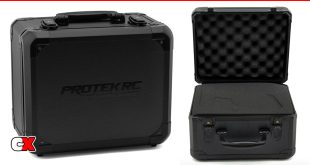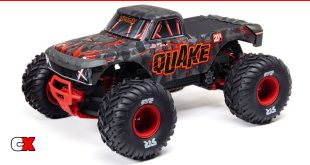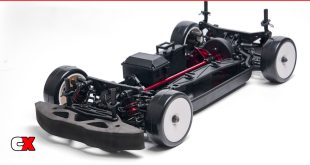
HPI has been very involved in the scale RC racing that has been going on lately. With a HUGE selection of realistic bodies, spoked wheels and treaded tires, a few ‘fun’ segments of the RC industry continue to gain strength. For instance, the RCGT class…an onroad class where drivers are required to run treaded tires, spoked wheels and a realistic body (basically, none of the Mazda6 or Stratus type bodies with all the drippy paint). Then there’s the Drift scene, where drivers again choose a realistic body, drift tires and wheels from HPI to build some beautiful drift-creations! Instead of just pure performance, both of these segments put an emphasis on realism.
I now present you the next step in offroad realism…the Mini TSA Trophy Truck. The Mini TSA not only fills the realism shoes, but stuffs them so tight they’re about to burst! On top of that, the performance for this mini-desert fighter is pretty impressive too!
THE FACTS
WHO MAKES IT: HPI
WHO IT’S FOR: Everyone
HOW FAST: 14.18mph
HOW MUCH: $240
BUILD TYPE: RTR
VEHICLE TYPE: 1/12th Scale Mini Trophy Desert Truck
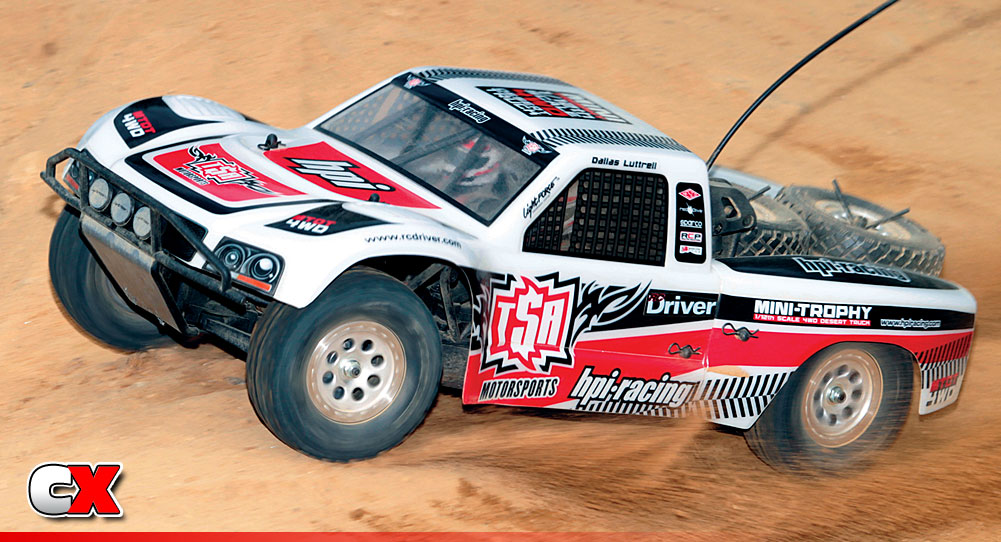
WHAT YOU NEED TO KNOW
• Let’s start with the obvious…the caging. On looks alone, the Mini Trophy truck is very impressive with all of its molded tubular framework everywhere. Fact is, all that caging is there for two purposes (well, 3 if you count the cool factor). One, it creates a pretty rigid cocoon around the trucks guts and helps protect them from damage. Secondly, like real trophy trucks, it creates a very durable platform that can withstand quite a bit of abuse!
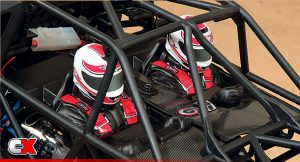 • The front suspension is very similar to a full size trophy truck. Upper and lower suspension arms reach out to the cast aluminum from steering knuckles, and a single threaded, plastic-bodied shock helps soak up all the rough terrain.
• The front suspension is very similar to a full size trophy truck. Upper and lower suspension arms reach out to the cast aluminum from steering knuckles, and a single threaded, plastic-bodied shock helps soak up all the rough terrain.
• Yes, that is what you see…one of the first mass-produced RC trucks with an actual 4-link rear suspension! Damping is controlled by another single threaded, plastic-bodied shock. Aluminum rear hubs are also included.
• While the Mini Trophy Truck is 4wd, none of the drivetrain sticks below the lower chassis! Front and rear gearboxes house fluid-filled differentials and are mated to a center transmission by a pair of plastic sliding drive shafts. Should you power-hungry junkies want a little more umph, a slipper unit is installed to help protect the drivetrain.
• While there may look like a lot going on in this truck, the CG is actually really low. The motor mounts to the center transmission but sits as low in the chassis as possible. The ESC mounts behind that. To offset those two items, the battery is cradled on the left side of the chassis.
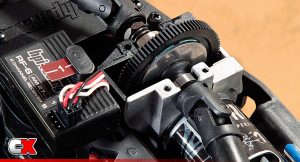 • Tires and wheels get the same uber-realistic treatment. Licensed Yokohama off road treads are wrapped around a shiny set of plated wheels. Chrome bead lock rings are included.
• Tires and wheels get the same uber-realistic treatment. Licensed Yokohama off road treads are wrapped around a shiny set of plated wheels. Chrome bead lock rings are included.
• Finally, HPI has added a ton of over-the-top items for maximum beauty points. Up front, a set of offroad lights are mounted to the bumper. A painted driver and navigator are installed into a semi-complete cockpit. Two spare tires are mounted to the rear of the truck on a caged arear that tilts up to allow access to the battery compartment. To top it all off, a trick looking body is mounted to quite a few locations on the cage (similar to the real thing!).
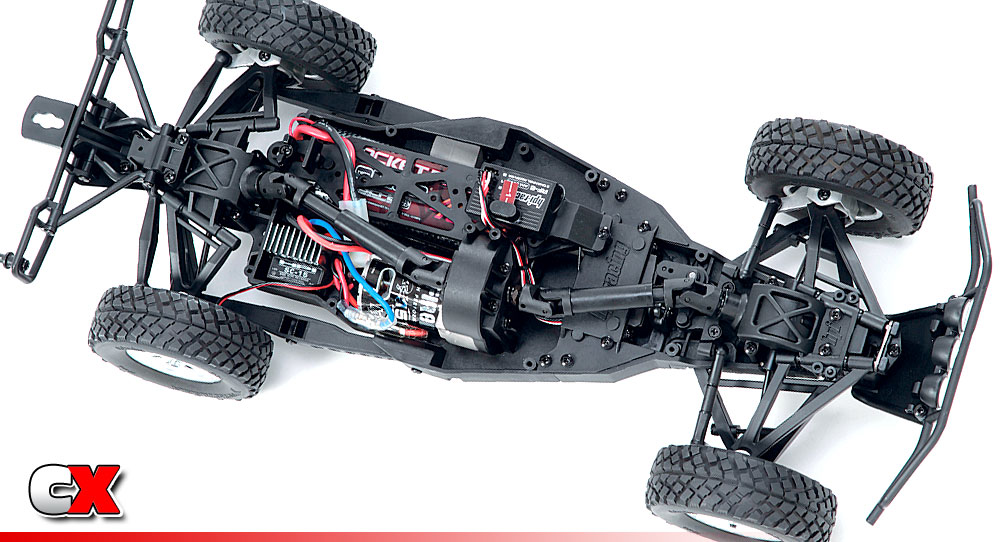
DESIGN ANALYSIS
• To keep the weight down low, the front and rear drive axles run up and over the top of all the electronics.
• While not easily seen in this photo, the body mounts to the cage a bit differently than most RC cars. One cool feature (and adding to the realism of the truck) is that the cab and bed can be removed from the truck independently from each other.
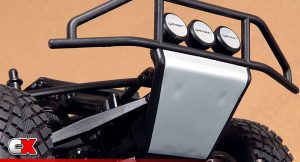 • HPI used hardened steel ring and pinion gears in the differential cases. This is great since most drivers who will buy the truck are going to drop in more potent power systems. The drivetrain should handle it.
• HPI used hardened steel ring and pinion gears in the differential cases. This is great since most drivers who will buy the truck are going to drop in more potent power systems. The drivetrain should handle it.
• The heavy-duty cast steering knuckle is the same front and rear, it’s just set-up as a hub in the rear, but in either case, I doubt you’ll be able to break one of these bulky pieces.
• We’re in the age of twist locks so the rear tire rack has a twist lock that holds it in place. Unlock it, hinge it up and you can access the battery strap and the twist lock tab that holds it in place. This truck is filled with neat little details.
• If you do plan on taking this machine apart for maintenance or hop-ups which I’m sure we’ll see many of, be prepared to do a lot of unscrewing. There are lots of screws that hold down this cage.
ITEMS NEEDED
– 7.2 or 8.4V stick pack, or 2S 7.4V LiPo
– Battery charger
– 8 AAs for the transmitter
ITEMS USED
+Team Orion 4000mAh 7.4v LiPo pack
+ElectriFly Triton Jr. Charger
+8 MaxAmps AA’s
TOOLS INCLUDED
+Camber gauge, 1.5, 2.0 and 2.5mm L-Type Allen wrenches and box wrench
TOOLS NEEDED
– A quality Metric Allen and Nut Driver set is recommended
PROS & CONS
+ Of course, everything about the incredibly scale looks
+ Sealed, metal-geared drivetrain
+ Full ball bearings, threaded shocks and even a slipper clutch are standard equipment
+ Industry standard 12mm wheel hexes allow you to swap to any 1.9 in. wheels
+ Officially licensed Yokohama Geolandar tires
– That it’s only available in 1/12-scale. I’d like one in 1/10 and 1/8 also, please.
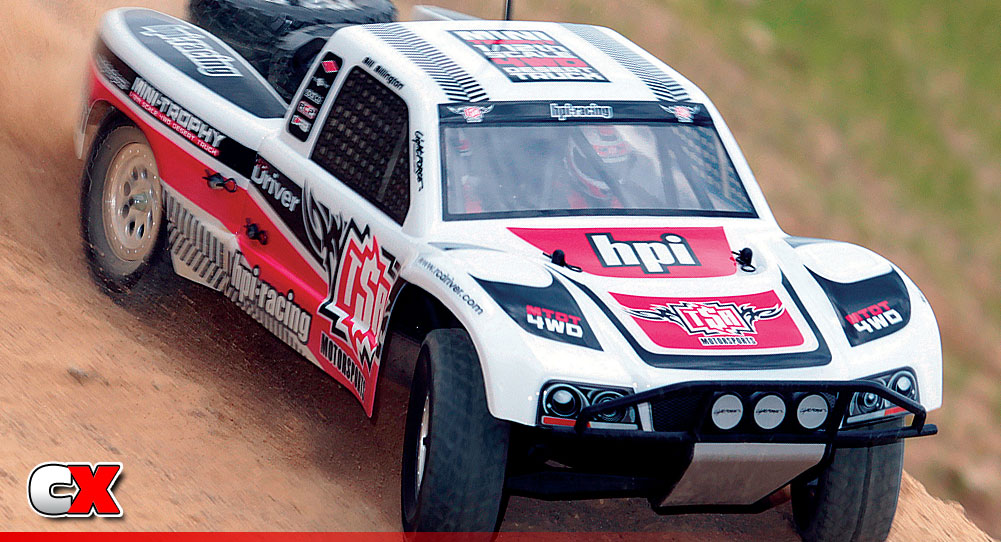
PERFORMANCE
Test Conditions: Dry, loose dirt lot
Since the HPI Mini Trophy Truck is built for pure fun and action, we’ll forego our typical broken out by section testing format and tell you about the awesome experience we had playing with this truck. A huge dirt lot with mounds, rocks and patches of grass served as our desert-like testing ground and was the perfect place to have fun with such a truck.
The first obstacle to attack was a group of large dirt mounds. I sent the MTT barreling up the mounds and right at the top of the mound I cut the wheels and carved a turn into the dirt spraying a roost of dirt off the backside of the mound. That was pretty cool, but the cooler part was actually focusing on the truck’s movements itself. As the truck went over the uneven dirt terrain, you can really see the suspension working hard to keep the chassis level, the rear wheels tuck up into the body as they go over bumps. Sometimes the whole rear end would bottom out and kick the truck up into the air and you would see the wheels drop out from the fenders. It looks so realistic!
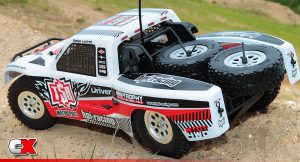 When going through corners, there is a decent amount of body roll that will tuck the wheels into the fenders on the outside of the corner. The wheels drop out on the inside resulting in a realistic looking full-scale pre-runner truck turn. Then throw in a little counter steering and the fun, excitement and enjoyment you purchased this truck for really begin to shine. The truck needs to be on really loose dirt to get it to break out the rear end. Otherwise the truck is pretty well planted and typically wants to push through corners. What’s really nice, though, is that it was hard to roll the truck in a flat turn even with all of its body roll.
When going through corners, there is a decent amount of body roll that will tuck the wheels into the fenders on the outside of the corner. The wheels drop out on the inside resulting in a realistic looking full-scale pre-runner truck turn. Then throw in a little counter steering and the fun, excitement and enjoyment you purchased this truck for really begin to shine. The truck needs to be on really loose dirt to get it to break out the rear end. Otherwise the truck is pretty well planted and typically wants to push through corners. What’s really nice, though, is that it was hard to roll the truck in a flat turn even with all of its body roll.
What could be better than the action this truck provides through corners? Jumps! Jumping the MTT is a lot of fun and very realistic. Yes, you can throttle the truck and get the nose to go skyward, but what’s cooler is watching the nose drop when in the air. When the truck landed in a nose down situation, I’d watch one front wheel hit the ground and tuck into the body, followed by the wheel on the other side of the truck. Then the nose levels out as the rear hits. As the rear hits the dirt, it sent a puff of loose dirt out from under the truck. It was so cool, just like what you see the real trucks doing in the desert. I could have jumped this truck all day and focused on its landings. It was awesome.
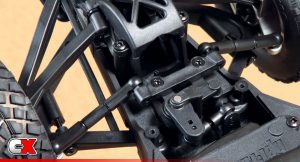 Finally I want to touch on the truck’s power system. Don’t expect to break any speed records and unfortunately I don’t think you’re going to be wowed by its speed at all. It hit a little over 14mph in front of our radar gun. The speed is fun for beginners and was plenty for some short burst action bashing, but we would like to have seen a little more speed out of a machine like this. The fact is though, most drivers are going to upgrade the power system and when we do, all of the cool driving attributes I just mentioned will only be enhanced even more. All-in-all, the HPI Mini Trophy truck is a hit, especially with the driver peering out from the cabin as you bash terrain that when scaled up would scare any 1:1 pro driver!
Finally I want to touch on the truck’s power system. Don’t expect to break any speed records and unfortunately I don’t think you’re going to be wowed by its speed at all. It hit a little over 14mph in front of our radar gun. The speed is fun for beginners and was plenty for some short burst action bashing, but we would like to have seen a little more speed out of a machine like this. The fact is though, most drivers are going to upgrade the power system and when we do, all of the cool driving attributes I just mentioned will only be enhanced even more. All-in-all, the HPI Mini Trophy truck is a hit, especially with the driver peering out from the cabin as you bash terrain that when scaled up would scare any 1:1 pro driver!
SPECS & TUNING OPTIONS
HPI Mini Trophy Truck
DIMENSIONS
LENGTH: 21 in. (533.4mm)
WIDTH: 9-3/16 in. (233mm)
WHEELBASE: 12-9/32 in. (312mm)
HEIGHT: 6-3/8 in. (162mm)
SUSPENSION
• Shock position- 2 holes on towers, 2 on lower arms
• Shock Damping- Optional oil, pistons and springs
• Toe- Rod spacers
DRIVETRAIN
• Diff stiffness— via grease
• Slipper clutch— Tension
• Gear ratio— optional pinions
MAINTENANCE AND TUNING TIPS
• The tub chassis can collect a lot of dirt so make certain to dump it out after each run so dirt doesn’t work itself into areas it shouldn’t be in.
• Be careful to tuck long battery wires away from the center driveshaft or balance wires when using LiPo packs.
• The rear of the truck sags pretty low and the chassis tends to slap the ground and kick the rear end around. I added just a little more preload to the rear shocks to raise the ride height and the truck was much more controllable.
• Monitor your electronic temperatures. With the ESC and motor tucked away in the chassis, there is not a lot of airflow. You might want to give a little cool down break to these components on really hot days.
THE LAST WORD
HPI could very well have developed a new racing class here. Its tiny footprint allows the track sizes to be much smaller, and seeing 5-10 of these little trucks dicing it out would be great! It will handle most terrain, requires little maintenance (thanks to the sealed drivetrain) and, with all that caging, is extremely durable. It’s plenty fast for beginners to really enjoy and it’s only a matter of time before there is a myriad of aftermarket support on the store shelves. Oh, and did I mention how absolutely cool it looks? With all of these positive features, why wouldn’t you want one!??! Heck…I want TWO!
LINKS
HPI, hpiracing.com
Team Orion, teamorion.com
Max Amps, maxamps.com
 CompetitionX CompetitionX is the most up-to-date source for RC Car News, Reviews and Videos for Radio Control. We also have the most comprehensive Manual Database on the web.
CompetitionX CompetitionX is the most up-to-date source for RC Car News, Reviews and Videos for Radio Control. We also have the most comprehensive Manual Database on the web.
